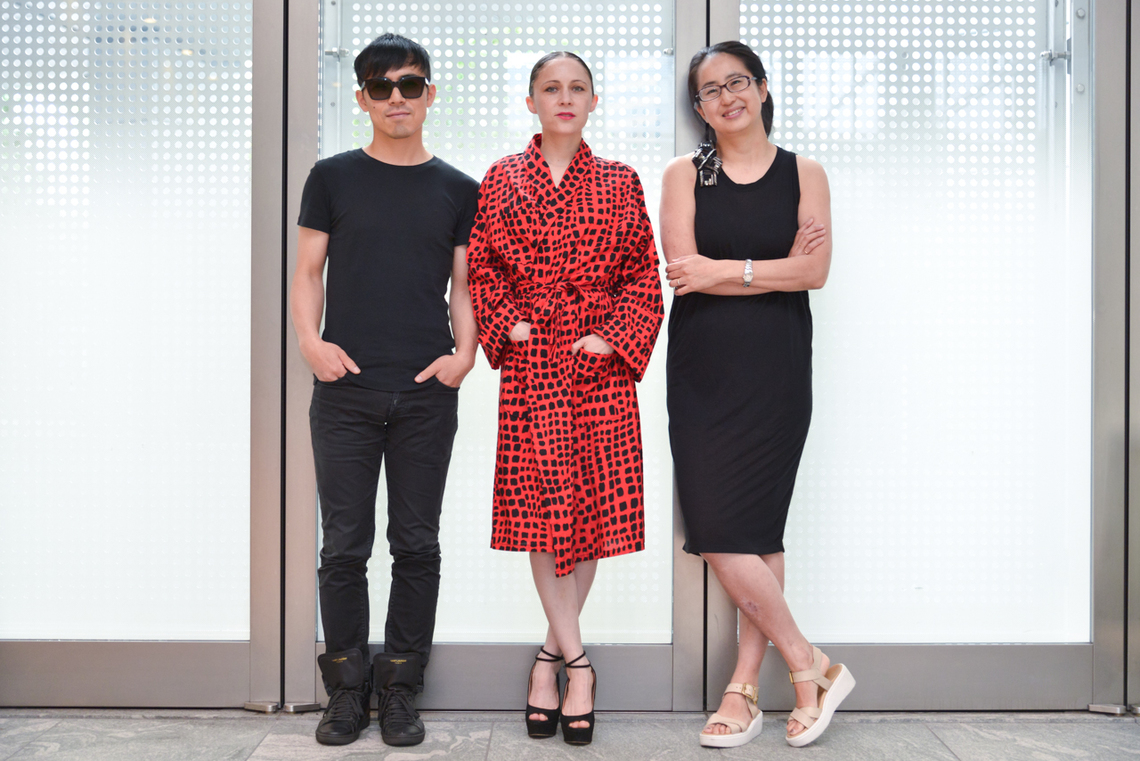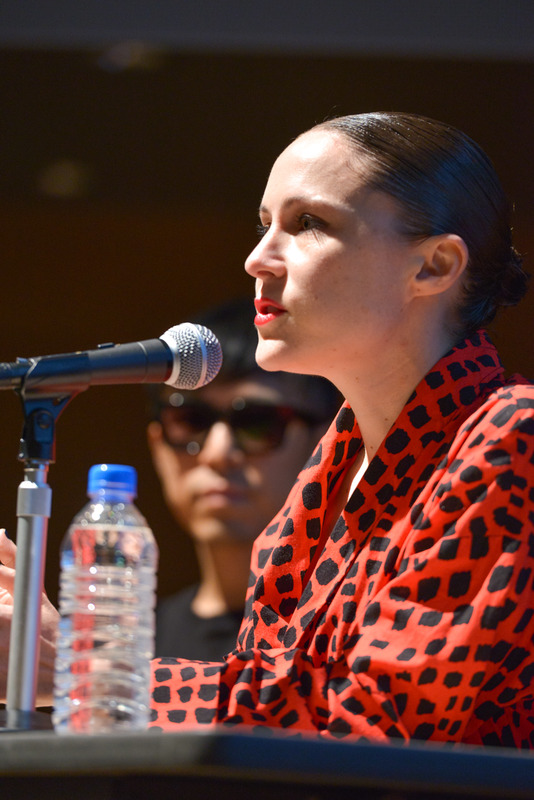Dentsu Inc. Design Talk #120, titled "Creating New Media Forms with Fashion Imagery! Fashion Branding," featured Tomoyuki Yonezu, Tiffany Godoy, and Ayumi Gunji. The creative unit "EROTYKA" by Yonezu and Godoy operates between Paris and Tokyo, globally distributing their cutting-edge magazine 'THE REALITY SHOW'. Ms. Gunji, after editing roles at Kodansha's "GLAMOROUS" and Condé Nast Japan's "VOGUE Girl," recently transitioned to become Fashion Director at Fusosha's "Numero TOKYO." All three leverage fashion as their foundation, pursuing Tokyo's potential while active on the international stage. We present their discussion on fashion's communicative power and branding in the global era across two parts.

I want to use Japan's unique fashion sense to create something new to share with the world.
Tiffany: I was born in Los Angeles and have always loved fashion and photography. I was particularly fascinated by Japanese fashion and culture. I first visited Japan in 1997 at age 17. My first magazine job was also in Japan, working at the editorial department of 'composite'. I came to Japan wanting to understand why Japanese people have such fashion sense – seeking a deeper cultural study rather than just fashion. After that, I worked as a fashion editor for STUDIO VOICE. Around that time, everyone started using the internet regularly. From the world's perspective, I was seen as someone who knew Japan from the start. I began writing articles about Japanese culture and edgy fashion for The New York Times and Style.com, starting my work with overseas media. Through this fashion research, I published a book in 2007 about the history of Harajuku fashion with an American publisher, becoming known as an "expert on Japanese street fashion." I've hosted fashion programs for NHK, and recently my activities have become increasingly multifaceted.
Yonezu: I originally worked in graphic design. After working at an agency called Enlightenment, founded by Hiro Sugiyama, I've been freelance for about 12 years now. I've mainly worked in the domestic beauty and fashion scene, developing an interest in fashion from Japan to the world, and beauty from Japan to the world. I naturally met Tiffany when we were young. As we talked, we discovered we shared a deep common interest in fashion. Though our professions were completely different, we found a closeness in terms of direction. I thought, "Couldn't we form a team and develop things together?" So, I proposed forming a team with her. That's when we created the name "EROTYKA" and started working together around 2004.
| |
 |
Tiffany: One thing I originally wanted to do in Japan was to use Japan's unique fashion sense to create something new to share with the world. I believed Tokyo could do things that London, New York, Paris, or Milan couldn't. Global culture was just starting back then, so visual expression was more important than words. I thought teaming up with an art director like Mr. Yonezu would allow for broader communication.
Yonezu: Amidst that, a specific opportunity arose. We received a proposal from BIG magazine, a New York fashion and culture magazine: "We want to publish an issue themed around 'Tokyo'. Could you handle the editing and art direction for us?" However, just as we were about to present our ideas, the Lehman Shock hit. The magazine was forced into discontinuation, and the project vanished. It was a huge shock, but the concept we had to execute had already taken shape. So, the two of us decided we had no choice but to do it ourselves.
Launching 'THE REALITY SHOW' with 'Reality' as its Theme

Yonezu: So, we thought "reality" would become the most symbolic theme of the new era. That's why we launched a magazine called 'THE REALITY SHOW'. At that time, we felt the first issue should be the purest expression of our own media. We turned down all advertising offers and focused on creating the most symbolic expression possible.
Tiffany: For the first issue, we featured model Ai Tominaga, but we also did street casting, showing a mix of streetwear and high-end brands. It was street snap photography, but with very strong art direction in the portraits—a mix of blog and book, high and low imagery. We felt existing media lacked real fashion stories and creativity, feeling too rigidly formatted. Conversely, a new reality was emerging: people's personal blogs had huge followings, and people walking around Harajuku were more inspiring than flipping through fashion magazines.
Expressing fashion's potential through both print magazines and digital media
| |
 |
Yonezu: Besides this 'THE REALITY SHOW', I've traveled globally meeting various creative industry professionals, carrying books like Tiffany's Harajuku project and collaborative works with fashion brands. They gave it extremely high praise, leading to my joining an art director agency in Paris. From there, we decided to create the second issue of 'THE REALITY SHOW'. To make a global impact with fashion media, we felt Japan's top photographer, worthy of worldwide pride, was Nobuyoshi Araki. So, we dedicated the second issue to a Nobuyoshi Araki photo shoot.
Tiffany: Around that time, we also launched our website. Wanting to create global buzz, we uploaded a promotional video on the popular site NOWNESS.com. From this point on, we began expressing fashion's potential through both print magazines and digital media.
Yonezu: Our magazine is sold in New York, Paris, London, Milan, Germany, and other locations. The second issue was seen by someone at Chanel's Paris headquarters, leading to a proposal: "Could we collaborate on something for 'THE REALITY SHOW'?" That resulted in the third issue, the "Chanel Issue," created exclusively with Chanel haute couture.
As we discussed next steps with Tiffany, we couldn't ignore the reality that fast fashion continues to gain momentum. For women everywhere, the real issue is truly financial—how much money they can actually spend on fashion. Thinking about that, we realized that even if women buy fast fashion clothing, there must be desires that fast fashion alone can't satisfy. We saw the potential for beauty products like cosmetics to fill that gap. Fashion isn't just about clothing anymore; we believe the definition of fashion will continue to expand, encompassing everything from beauty to lifestyle.
Tiffany: The issue's title was "Beauty is the New Fashion." Cosmetics are the luxury anyone can afford.
Aiming to be the world's top beauty advertising agency

Yonezu: We understand how crucial beauty is as a visual medium in photography. Within that context, we experimentally launched both a big-format magazine and an iPad magazine simultaneously.
Tiffany: Another key point with 'THE REALITY SHOW' is our commitment to doing something innovative every issue. For this one, we used beauty photos with almost no retouching. We made the images used in the iPad magazine and the print magazine exactly the same, showing them as if they were moving on the iPad. Essentially, it's a "moving poster."
Yonezu: Another point is that the fashion industry is an extremely competitive world where the staff involved, who you shoot with, and which models appear are crucial. Since we're aiming to compete at the forefront of the fashion world, we shot in New York with the intention of conveying that message – so people would see it and recognize, "Ah, that model is ◯◯."
Tiffany: For example, there are only about five top fashion art directors in the world. Their changes alone drive global campaigns. So, we aim to seize opportunities in beauty and aspire to become the world's top beauty art directors. We significantly elevated the music and text used overall. We shot everything with 4K cinema cameras, and a single capture from that footage became a single photo in the magazine. That was also an experimental expression of beauty's potential for the future.
Tiffany: The fifth issue was conceptualized around fetishism and created in collaboration with Cartier. The casting here also features prominent figures, including fashion muse Catherine Baba.
Using the magazine as a platform for digital dissemination
Yonezu: The latest issue #6, released at the same time as #5, featured a special section called "Tokyo Camouflage" created with Emporio Armani.
 |
|
Tiffany: Based on the concept of "things only possible in Tokyo," we cast young people around 20 years old who are currently popular on Instagram. We mixed their own clothes with Emporio's clothes and shot in various locations around Tokyo. It's like a fashion guidebook concept.
Yonezu: Another key point this time was holding a "Style Battle" featuring the 25 Tokyo cast members. While everyone was dressed up for the magazine shoot, we also photographed them against a white backdrop to create GIF animations displayed on the website. We set up a system allowing mobile voting for one week, with the winner earning the right to be featured as a poster in the magazine. We experimented to see if we could bridge social media and the magazine. At the same time, we developed an iPhone app. It was a game app where you could tap and swipe through the photos of the 25 people we shot, then create your own collages.
Tiffany: We launched this issue at Colette, a top Parisian select shop, coinciding with its release.
Yonezu: While we promote it as a magazine, we deliberately think in terms of "media expansion." Why? Because in this era, we're exploring how to use the magazine as a platform to digitally expand and disseminate content—how to effectively leverage web, social, apps, and various media to create buzz. We see the magazine as the foundation for this media expansion.
Tiffany: From the start, we've collaborated with people and brands. While maintaining our niche position, we plan to gradually expand our collaboration partners, locations, and methods. So, while keeping our exclusive format, we aim to communicate more with the masses. Especially for young people, it's visual culture, so a global community can form regardless of location. We're also operating very flexibly worldwide.
※Part 2 will be updated on Friday, September 19.
Planning & Production: Aki Kanahara, Dentsu Inc. Human Resources Bureau Article Editing: Sugatsuke Office Structure Cooperation: Eiji Kobayashi











